Patty Carroll talks about her “Anonymous Women” photo series
She calls them ”unportraits.“
• February 2018 issue
Famous in her anonymity
Someone once asked Patty Carroll to describe herself in one sentence. She answered, “I am someone who loves to dance with images.” Sitting in her compact, white-walled, oak-floored Chicago studio, a half-completed “unportrait” installation on an 8x8-foot stage set in front of her, she smiles when reminded of her response.
“I love dancing, and I love images,” she explains, brushing back her blonde hair. “Images are everything to me—I’m very visually oriented—and when I’m creating a picture it’s like I’m dancing, adding pieces, taking them away, playing with a composition until it’s just right.”
Judging from the carefully constructed set before us—a 1950s-era kitchen stocked with vintage plates, polka dot drapes, and a mannequin’s legs and arms jutting out from the kitchen sink—she’s in the middle of some intriguing choreography. “It’s a work in progress,” she explains with a gentle laugh. “I’m not there yet but I’m close. I’m still dancing.”
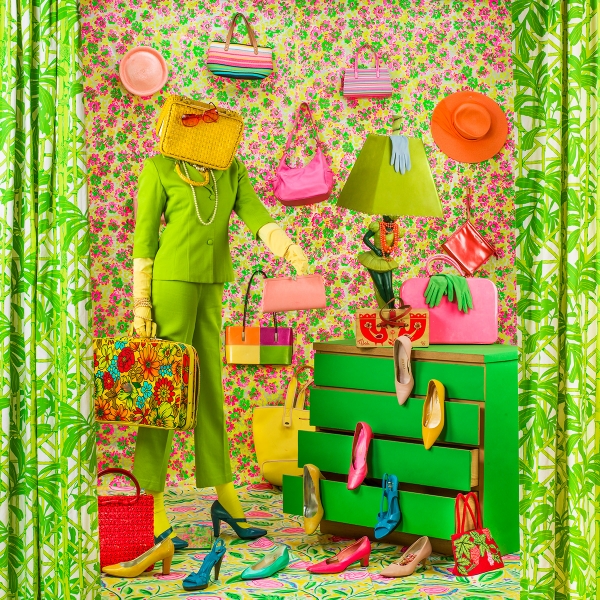
“Oh, that’s what I’m doing.”
Carroll, 71, has been a photographer and photography teacher—at Chicago’s School of the Art Institute, London’s Royal College of Art, the University of Michigan, and elsewhere—since the early 1970s. She’s had numerous one-person shows of her photographs and published several collections of her work, including “Living the Life: The World of Elvis Tribute Artists,” a book on Elvis impersonators, and “Man Bites Dog: Hot Dog Culture,” a quirky look at a colorful slice of iconic Americana. Her photography has won numerous awards and is included in several museum collections, including the Museum of Modern Art, the Art Institute of Chicago, and the Museum of Contemporary Photography. She is represented by two galleries, and prints of her work sell for up to $3,500.
She’s perhaps best known for her most recent project, “Anonymous Women,” a three-part series of staged photographs created over the past two decades recently published as a 112-page book. These strikingly colorful and lushly staged compositions feature female figures draped in, hiding behind, or camouflaged by lavish fabrics in elaborate settings of Carroll’s own design. As her publisher has noted, Carroll’s images “symbolize the psychological states of women around the world by showing them hidden behind, and intertwined with, visually stunning domestic scenes.”
“I don’t want to over-intellectualize my work,” she explains. “I’m one of those photographers who likes to run with an idea, not someone who thinks of a theory first and then works from that. It’s not until much later, when I’m well into my work, that I realize, Oh, that’s what I’m doing! and understand how it may fit into my world view.”
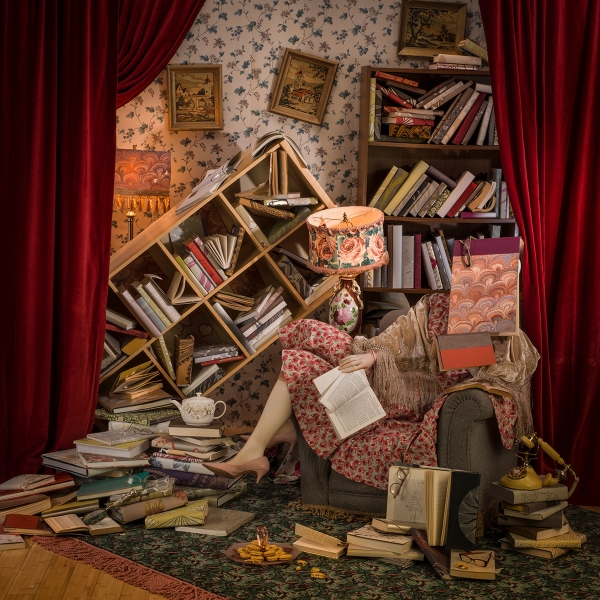
While Carroll has explained that “Anonymous Women” is a comment on an “obsession with excessive collecting, accumulating, designing and decorating,” she is quick to add that she is laughing at herself and other women when, as she notes, “We lose perspective and become possessed by our material goods. We just have too much stuff!”
“I’ve called these pictures ‘unportraits’ because they are not real portraits,” she says. “They are more portraits of types or issues but not of people.” While people have commented that her photographs of women in various phases of anonymity could be interpreted as everything from commentaries on women’s fight for identity to digs at commercialism, Carroll is happy for viewers to read what they want into her work. “I’m just happy to get a conversation started. I want viewers to reach their own conclusions.”
She recalls the opening of a recent showing of her work in Shanghai, where several audience members asked her, “Who is the woman under the drapes?”
“I told them it didn’t matter. I explained that it could be any of us,” remembers Carroll. “But they kept asking even though I said that she is anonymous and represents all of us. This still didn’t stop them.”
“We know, we understand,” they told Carroll. “But who is she, really?”
Carroll breaks into a hearty laugh as she confesses, “Finally I told them it was Meryl Streep. And that ended that!”
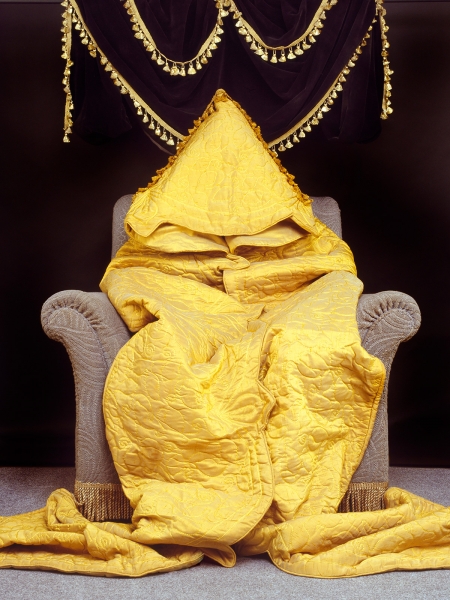
“I’m not a geek.”
Carroll points to her time in England in the early 1990s as the inspiration for the “Anonymous Women” series. She had moved to London from Chicago with her husband, Tony Jones, when he took a job as director of the Royal College of Art. Although she had a position teaching photography, she felt displaced, she says. “Suddenly I had become ‘Mrs. Jones.’ My domestic status eclipsed my professional status and ‘Patty Carroll’ seemed to disappear. I felt like I lost my bearings. I felt anonymous.”
On a whim she began photographing a model she had painted white (“to resemble a classical sculpture”) and then had the idea to put food and other objects on her face to obscure her identity. “That’s how all this started,” she explains.
After returning to the United States, Carroll continued exploring the idea of anonymity, eventually fleshing out the “Heads” series and following that with “Draped,” in which women were hidden behind bolts of fabric, and “Deconstructed,” where women seem to merge, again anonymously, with their possessions. “The woman in my work was becoming part of her stuff, which was also overwhelming and obscuring her,” says Carroll.
Inspiration for her shoots can come from anywhere. Sometimes a single object will suggest a scene. When she spotted a friend’s beige, vintage phone she asked to borrow it. “It turned out he had lots more and I took a sack-full of them with me to my studio,” says Carroll. “They became the basis for a picture. It’s often serendipitous like that.” Another friend’s vintage toaster inspired another photograph.
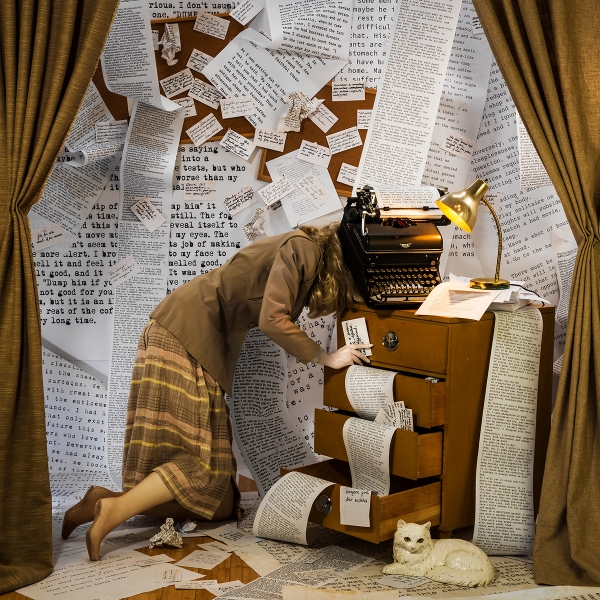
Other times she haunts thrift shops and estate sales hunting for vintage drapes, fabrics, and “just the right” items needed to complete a studio installation. “I can also dip into my closet full of vintage clothes I’ve bought for photographing over the years,” she says. Sometimes Carroll has help building scenes, and for complex, longer shots uses a mannequin instead of a model.
While furnishing the scene, adding and deleting items, she makes sample photos with a medium-format Hasselblad H5D until she strikes a composition she likes. Her lighting is basic: “I’m not a geek. I’m still using the softboxes I bought from a photography student in 1980!” It can take anywhere from a couple of days to a week, sometimes even longer, to produce a photo.
“She has had a great life”
Although Carroll has several times been quoted as being about to “kill off” her anonymous woman, she denies the end is nigh: “She has had a great life and I admit I’ve thought of doing her in. But then I get another idea and revive her. The poor thing is having a lot of domestic issues. Her stuff keeps overwhelming her. Until we do a coffin picture, she’s not dead.”
Then, after a pause, Carroll adds, “I have thought of killing her. But I’ve also thought of bringing her back as a queen who will rule the world. Why not? It’s women’s turn.”
RELATED: Gallery of Patty Carroll's "Anonymous Women"
Robert Kiener is a writer in Vermont.

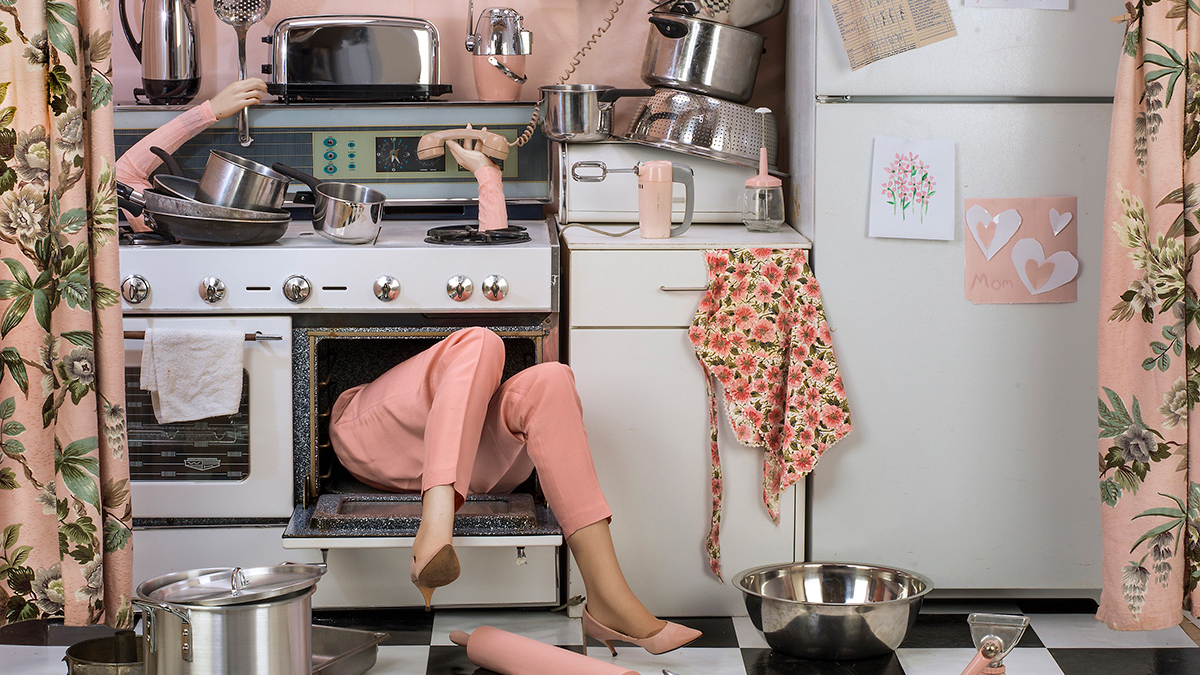
 View Gallery
View Gallery


